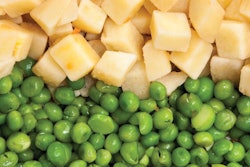
Did you know that for every dollar spent by U.S. consumers on human food in 2017, they spent about 6 cents on pet food? And except for a slight dip after the melamine pet food recalls and during the recession, that figure has steadily risen from 5 cents in 2001 — coinciding, not surprisingly, with the rising popularity of premium pet foods.
This data came from Jayson Lusk, Ph.D., head of the Department of Agricultural Economics at Purdue University and a speaker at the Ninth Annual Feed and Pet Food Joint Conference, held September 17-19, 2018, in St. Louis, Missouri, USA. The conference was presented by the National Grain and Feed Association and Pet Food Institute.
Pet food spending increases outpace human food
Lusk also shared a chart comparing increases in spending on pet food and other pet products and services to overall spending as well as human food expenditures. With 2001 as the starting point and plotted as 100 on an index, pet food reached 173 on the index by 2017 — in other words, a 73 percent rise since 2001 — compared to 125 for spending on food at home, 136 for all U.S. consumer spending and 151 for spending on food away from home.
The pet food spending matched that for all pet-related products and services, yet the biggest gain happened for veterinary and other pet services, at 225. Also, data from the U.S. Bureau of Economic Analysis showed that consumer demand for all pet products (the agency doesn’t break out pet food spending, Lusk said) increased from an index of 100 in 2001 to nearly 450 in 2017.
Specific to premiumization, Lusk cited an older study, from 2009, indicating that premium pet foods accounted for 25 percent of U.S. spending at that time, selling at a 62 percent premium. A dip in 2007 occurred, the researchers said, because higher-volume purchasers spent less. Those who continued to spend the most on premium pet foods also tended to purchase premium human food, have high incomes and be younger. (No surprises there, either, except for perhaps the younger purchasers.)
Science is out for pet food and human food
While Lusk’s presentation included many other data points, most familiar to us from sources like the American Pet Products Association, he used them to establish context for his main message: consumers’ preference for premium products, whether human food or pet food, as well as their heightened awareness of the foods they buy and where they come from, has led to a move away from science and possibly food safety.
“Science is out, natural and ‘clean’ are in,” Lusk said. For an example from human food, he shared data from a survey he conducted, in which he asked consumers how they thought the challenges of feeding a growing global population should be addressed: 76 percent said they would adopt a more natural food system, while only 23.77 percent preferred a more technical approach.
With pet food, he said the focus on premiumization and clean labels could mean that consumers (and, consequently, brands) may eschew chemical-sounding ingredients, yet those are often antioxidants and other substances that help ensure safe products.
His assertion was supported by another speaker, Susan Schlueter, director of marketing for Nestlé Purina PetCare. When her company conducted a survey that presented the chemical name for a form of vitamin K often used in pet food (menadione sodium bisulfite), 59 percent of consumers said they would never purchase a product with that ingredient. Yet when presented with the same name, but with “vitamin K” in parentheses after it, the percentage of people who wouldn’t buy it dropped to only 19 percent.
Communicating to pet owners: Culture is key
I’ll share more from Schlueter’s presentation on consumer insights soon, but it’s worth mentioning another concept hers had in common with Lusk’s presentation: that consumers are quickly migrating to “food tribes.” In other words, adopting and avidly following specific types of diets (gluten free, paleo, keto and the like), which we know is also carrying over to pet foods.
Lusk presented the same idea in terms of U.S. consumers’ food values and tribes extending beyond food. When asked to choose what aspects of food are most important to them, consumers have over time consistently said the same four things: taste, safety, nutrition and price. They far outweigh other values such as naturalness, animal welfare, environment and origin — though Lusk commented that some of the lower-ranking values are likely tied to those core four; for example, naturalness may connote better taste or nutrition for some consumers.
What’s striking is how people from different “tribes” — for instance, adopting particular political leanings or stances — rank values such as animal welfare, price or the demand for meat. Just as with so many other areas of today’s society, there is a lot of polarization, which affects how consumers accept science and technologies that could aid food production. Lusk presented an interesting illustration of how voters in California voted, by county, very similarly for issues as disparate as gay marriage and mandatory GMO food labeling.
The key takeaway? We’re social beings, so our cultural values shape our risk perceptions and related beliefs, Lusk said. And that’s important to keep in mind while communicating to pet owners about things they care deeply about: namely, their pets’ food and nutrition.

















